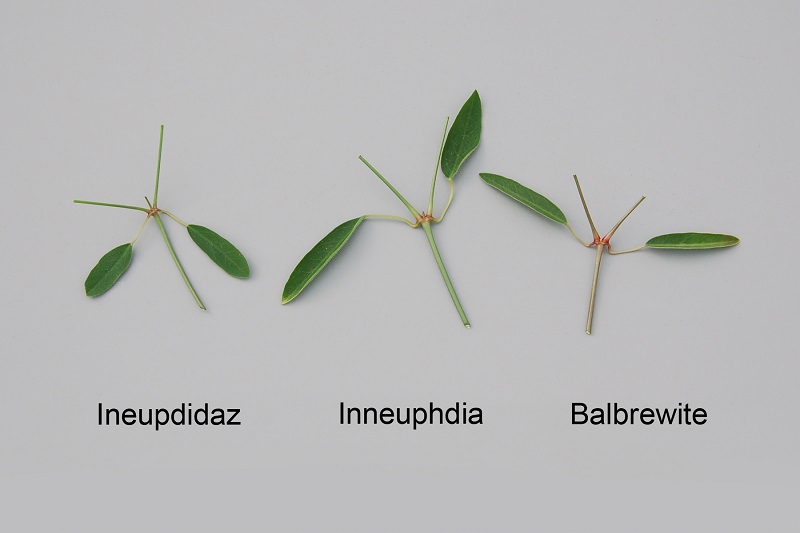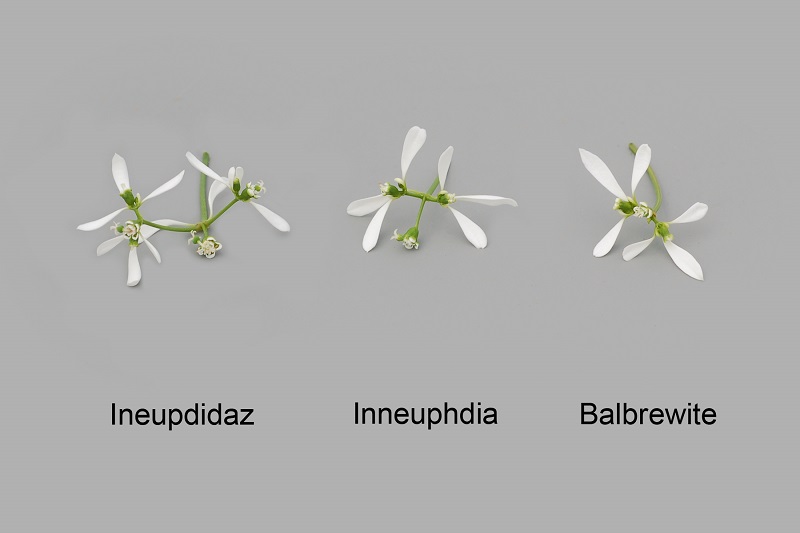Ineupdidaz
| Denomination: | 'Ineupdidaz' |
|---|---|
| Trade name: | Diamond Delight |
| Botanical Name: | Euphorbia hypericifolia |
| Applicant/Holder: |
InnovaPlant Zierpflanzen GmbH & Co. KG Postfach 113 D-55454 Gensingen Germany |
| Breeder: |
Birgit Hofmann, InnovaPlant Zierpflanzen GmbH & Co. KG, Germany |
| Agent in Canada: |
BioFlora Inc. 38723 Fingal Line R.R. #1 St. Thomas, Ontario N5P 3S5 Canada Tel: 519-317-7511 |
| Application Date: | 2014-03-17 |
| Application Number: | 14-8234 |
| Grant of Rights Date: | 2016-06-30 |
| Certificate Number: | 5269 |
| Date rights surrendered: | 2020-06-30 |
Variety Description
Varieties used for comparison: 'Inneuphdia' (Diamond Frost) and 'Balbrewite' (Breathless White)
Summary: The plants of 'Ineupdidaz' are shorter than the plants of 'Inneuphdia'. The degree of branching of the plants of 'Ineupdidaz' is dense whereas the branching of the plants of the reference varieties is of medium density. The intensity of anthocyanin colouration of the stem of 'Ineupdidaz' is weak whereas the intensity is strong for 'Balbrewite'. The stem of 'Ineupdidaz' is thinner than the stem of both reference varieties. The pubescence of the upper side of the leaf blade is very sparse for 'Ineupdidaz' whereas the pubescence is sparse for 'Balbrewite'. The bract of 'Ineupdidaz' is narrower than the bract of 'Inneuphdia'.
Description:
PLANT: vegetatively propagated, annual type, bushy-rounded growth habit, dense branching
STEM: light green to medium green, weak intensity of anthocyanin colouration, absent or very weak glaucosity, absent or very sparse pubescence, thin to medium thickness, smooth shape
PETIOLE: long
LEAF BLADE: opposite arrangement along stem, simple type, elliptic shape, acute apex, cuneate base, entire margin
LEAF BLADE (UPPER SIDE): no glaucosity, very sparse pubescence, brown green (more yellow than RHS 137A-B)
LEAF BLADE (LOWER SIDE): sparse to medium density of pubescence, brown green (closest to RHS 137C)
BRACT: obovate shape, white (RHS NN155D)
Origin & Breeding History: 'Ineupdidaz' is a product from a planned breeding program that took place in Heidesheim, Germany where it was bred and developed by the breeder, Mrs. Birgit Hofmann. It originated from a controlled cross conducted in July 2011 between a proprietary seedling designated 'ch10-2100-10', as the female parent, and a proprietary seedling designated 'ch10-2101-21', as the male parent. From the resulting progeny, 'Ineupdidaz' was selected in August 2012 for its excellent branching, ability to flower freely, pure white bract colour, and increased number of bracts compared to traditional Euphorbia. 'Ineupdidaz' was first propagated asexually by vegetative cuttings in October 2012 in Gensingen, Germany.
Tests & Trials: The comparative trial of 'Ineupdidaz' was conducted in a polyhouse during the spring of 2015 at BioFlora Inc. in St. Thomas, Ontario. The trial included a total of 20 plants each of the candidate and reference varieties. All plants were grown from rooted cuttings that were each transplanted into a 15 cm pot on April 15, 2015. Observations and measurements were taken from 10 plants or parts of plants of each variety on May 21, 2015. All colour determinations were made using the 2007 Royal Horticultural Society (RHS) Colour Chart.
Comparison tables for 'Ineupdidaz' with reference varieties 'Inneuphdia' and 'Balbrewite'
Plant height (cm)
| 'Ineupdidaz' | 'Inneuphdia' | 'Balbrewite' | |
|---|---|---|---|
| mean | 18.7 | 22.2 | 18.3 |
| std. deviation | 1.00 | 1.52 | 1.12 |
Bract width (mm)
| 'Ineupdidaz' | 'Inneuphdia' | 'Balbrewite' | |
|---|---|---|---|
| mean | 2.0 | 3.0 | 2.0 |
| std. deviation | 0.00 | 0.00 | 0.00 |
Click on image for larger view

Euphorbia: 'Ineupdidaz' (left) with reference varieties 'Inneuphdia' (centre) and 'Balbrewite' (right)
Click on image for larger view

Euphorbia: 'Ineupdidaz' (left) with reference varieties 'Inneuphdia' (centre) and 'Balbrewite' (right)
Click on image for larger view

Euphorbia: 'Ineupdidaz' (left) with reference varieties 'Inneuphdia' (centre) and 'Balbrewite' (right)
- Date modified: